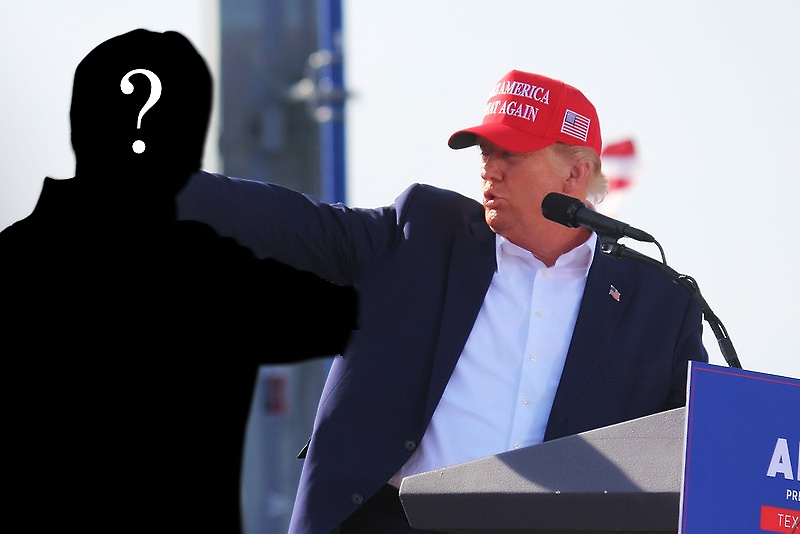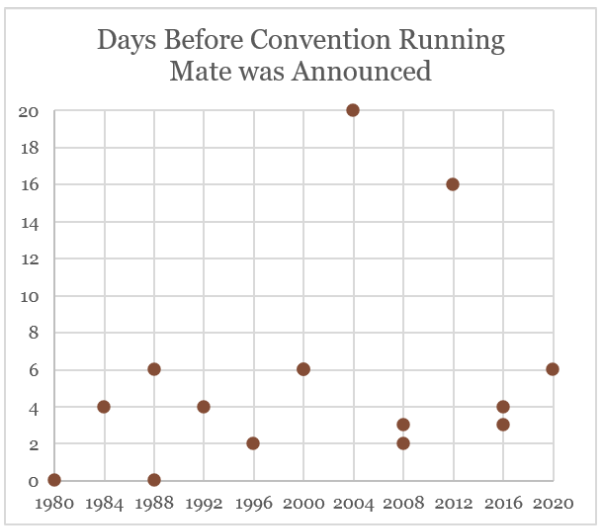
When Trump Might Name His Running Mate, and Why He Should Wait
Whether they’re showing up at his trial, on stage with him at some rally, or dispersed all over television networks praising his name, Donald Trump’s major vice presidential contenders are slowly but surely willing themselves into becoming household names.
So far, there’s nothing to show for the deluge of vice presidential wannabes flooding the airwaves, rallies, and courtroom. Trump sometimes hints he’s leaning one way, then cautions he hasn’t made up his mind. We certainly have some thoughts about who might be the strongest running mate for Trump, but we want to think strategically here: when are announcements usually made, and when should Trump announce?
Historically, at least in modern history since 1980, running mates are picked within one month of the party’s convention – on average, about five days before:
| Year / Party | Nominee / Running Mate | Days Before Convention Running Mate was Announced |
| 1980 – R | Reagan / H.W. Bush | 0 (during convention) |
| 1984 – D | Mondale / Ferraro | 4 |
| 1988 – R | H.W. Bush / Quayle | 0 (during convention) |
| 1988 – D | Dukakis / Bentsen | 6 |
| 1992 – D | Clinton / Gore | 4 |
| 1996 – R | Dole / Kemp | 2 |
| 2000 – R | W. Bush / Cheney | 6 |
| 2000 – D | Gore / Lieberman | 6 |
| 2004 – D | Kerry / Edwards | 20 |
| 2008 – R | McCain / Palin | 3 |
| 2008 – D | Obama / Biden | 2 |
| 2012 – R | Romney / Ryan | 16 |
| 2016 – R | Trump / Pence | 4 |
| 2016 – D | Clinton / Kaine | 3 |
| 2020 – D | Biden / Harris | 6 |
It used to be more common to make the announcement right at the convention, as the 1980 and 1988 Republican announcements illustrate, but the trend is pretty clear: 73% of picks have been announced in the week leading up to the convention.

What is quite clear is that, to quote from our 2020 article on the subject: it’s unusual for a modern campaign to announce a running mate more than a few weeks — let alone several months — before the convention. Given that the Republican National Convention is set to kick off on July 15, that puts the likely window for an announcement almost assuredly within the month of July, and probably somewhere between July 7-13th.
In 2020, we aptly noted that Biden was likely to stick to a time-tested tradition (as that’s sort of a hallmark of his whole shtick) and reveal his running mate closer to the convention, even though the coronavirus and the novelty of that particular election may have called for an earlier reveal once he sealed up the Democratic nomination. Though Trump has said he’ll likely wait until closer to the July convention, it seems intuitive that the flipside point holds true here too: if there’s one thing Trump excels at, it’s upending time-tested tradition in favor of his own whims. So maybe his hints that he’ll make a decision sooner rather than later should be earnestly considered. But is that a sound strategy?
There’s No Harm in Waiting
A VP announcement serves two logistical purposes: one, it’s a high profile piece of news for the campaign at large, boosting coverage and fundraising; two, it focuses voters on the general election, as it is really the last remaining ticketing decision, signaling the forthcoming showdown.
Both of these purposes have strategic consideration, but we’re fond of leaning on the golden rule of vice presidential picks – to do no harm. This maxim is valuable because it captures the conundrum of the running mate selection: people are going to vote based on the party, or who is at the top of the ticket; a vice presidential pick can only alienate people or turn them away (looking at you, Sarah Palin). In other words, it’s rare to see people vote for you because you picked a given running mate, but it’s much more common to see people turned off from voting for you because you picked a running mate they don’t like. If you’re a presidential candidate, you want buzz for your ticket, but you want it to be good buzz – and you probably want it to be good buzz about you.
This isn’t even necessarily about a running mate doing something stupid down the line – as the Kristi Noem and Cricket the dog saga illustrates, dirt or personal blunders may yet still be uncovered with just months to go to the election. If the Noem story had come out in October of 2024, a couple months after she’d been named, it’d be just as bad – but if Trump picked Noem in early April, he’d be tied to her and this narrative. By waiting, you’re shrinking the risk window.
The benefit of waiting until a few days before the convention, particularly in a year like this, is that it allows a streamlined rollout, minimal time for scrutiny before the main event, and then – even if something goes a bit wrong – the incumbent party’s convention usurps the spotlight anyway.
At worst, the downsides to waiting are that the campaign loses out on a helpful surrogate being deployed earlier (an actual campaign stop is more engaging than a “potential running mate comes to give speech” stop). That’s of marginal use for the reasons stated above – running mates don’t tend to bring in new supporters. Much of the fundraising surge, media coverage, and campaign momentum can be captured by simply waiting until just before the convention. Given that the 2024 election is already a particularly early cycle, where the major party nominees were both obvious frontrunners who sealed up the nominations quickly, where the entire country already knows who they are, and where the first convention will occur early, there is no harm in drawing this process out and keeping buzz alive by teasing a thorough vetting process of many individuals who have their own distinct relationships with the party’s base.
Whether it’s to spend additional weeks vetting someone even more thoroughly, to delay until a strategic moment to squeeze additional media attention out at a useful time, or to minimize the total amount of time that a running mate is subject to scrutiny, or all three, the Trump campaign would be wise to wait until the week before the convention, just like most campaigns do.